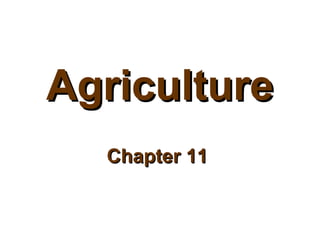
Agriculture part 1
- 1. Agriculture Chapter 11
- 2. Classification of Economic Activities • Primary or Extractive Activities Hunting & Gathering – Farming – Livestock raising or herding – Lumbering – Mining – Quarrying • Working in the natural environment- often the environment suffers.
- 3. Primary or Extractive Economy- Teak logs near Mandalay, Myanmar
- 4. Top picture-aquaculture or fish farming in Thailand Right-fishing, one of the most dangerous occupations in the world, is vital to many countries (Iceland, Japan, etc.), but fish stocks are running low due to over fishing in many parts of the world
- 5. Classification of Economic Activities • Secondary Activities – The stages are; Stone Age-Copper Age-Bronze Age-Iron Age, etc. – Manufacturing- converting raw materials into finished goods. – Major changes in human history marked by new ways to convert raw materials into
- 6. Classification of Economic Activities • Tertiary Activities provide essential services in a complex society – Doctors, dentist, hospitals – Lawyers – Teachers – Stores, shops – Banks, offices • Quaternary and Quinary are high tech and specialization – Administration – Research
- 7. Agriculture Agriculture – the purposeful tending of crops and raising of livestock in order to produce food and fiber.
- 8. • The Persistence of Agriculture • The US only has 2 million farmers. • Mechanization and farm consolidation have forced out many small scale farmers. • Yet US farm production is at an all time high. • IN MOST OF THE WORLD-AGRICULTURE REMAINS THE LEADING EMPLOYMENT SECTOR- 40% of the world’s population are farmers
- 9. Before Farming • Food production, preparation and consumption plays a major role in all culture. • Food taboos by custom or religion, food intolerances- dairy, eggs or fish, peanuts, etc. • Hunting & Gathering or Fishing was the only way to acquire food for most of our existence. – San of southern Africa – Aboriginals of Australia – Native Americans of Brazil
- 10. Bushmen of the Kalahari still live By hunting and gathering
- 11. Hunting & Gathering Societies • Settlements are NOT PERMANENT • Populations remain small • Early hunter-gatherers lived in wetter & better environments and had an easier life than those of the modern day. – Eastern North America- forests, wildlife & nuts – Pacific Coast Americas- salmon fishing – Aleuts of tundra caribou herds – Interior North America- buffalo herds
- 12. Hunting & Gathering Societies • Technology improved slowly • Bone & stone tools & weapons • Learned to control fire- protection-cooking • Metallurgy evolved with copper, bronze, gold and later iron for arrowheads, knives, axes and other utensils. • Even pre-agricultural societies had complex tools, utensils &
- 13. Hunting & Gathering Societies-Fishing • 12,000-15,000 yrs. Ago coastal flats were flooded as glaciers melted • Continental shelves became shallow seas where marine life was plentiful • Coastal areas became warmer and more habitable • Shell fish & trapped fish added to the diet as harpoons, spears, hooks, boats and
- 14. Agricultural Origins-The First Agricultural Revolution • The first domestication of plants was probably in South East Asia-root crops-taro, yams & bananas 14,000 years ago • Southwest Asia domesticated cereal crops such as wheat, barley & oats-10,000 years ago • MesoAmerica-maize (corn), squash & beans • Africa-millet, sorghum,
- 15. The Fertile Crescent – Where the planned cultivation of seed crops began. - because of seed selection, plants got bigger over time - generated a surplus of wheat and barley - first integration of plant growing and animal raising (used crops to feed livestock, used livestock to help grow crops)
Notas del editor
- Logs of Teak near Mandalay, Myanmar Lumber Mill
- Aquaculture in Thailand
- Chinese industrial air conditioner factory
- Soybeans in the semi-arid ranchlands of western South Dakota
- The # of farmers is the lowest since the mid-19 th century when the total population was only 20 million.
- Jakun (tribe an aboriginal tribe) blow pipe hunter at Tasek Chini in Malaysia on the mainland peninsula
- Top Left-Bushmen of the Kalahari gather berries Bottom Right-a Bushman aims his poisoned tipped, bone arrow at an animal in the dry grass plains of the Kalahari Desert. Also called the San-the live in small, scattered mobile bands. Most common prey are antelopes, wildebeest and other smaller game.
- Cooking made food more digestible and was used to drive animals over cliffs or into traps Thule artifacts from east side of Ellesmere Island northwest of Greenland, 2 small female ivory fetishes as well as stone, bone and antler tools, spear points, harpoon heads, etc. Spear thrower delivered 7 x more power than the traditional method of throwing a spear.
- Wood & bone or antler was often used for fish hooks or harpoon points. Seals and fish were hunted using these in pre-historic Scandinavia Pacific Coast and Arctic shores Ainu of Northern Japan And Western Europe-wicker baskets and stone traps used to catch salmon and other fish These fishing settlements had a degree of permanence due to the plentiful food supply
- Right-wheat-one of the 1 st seed crops to be domesticated.
